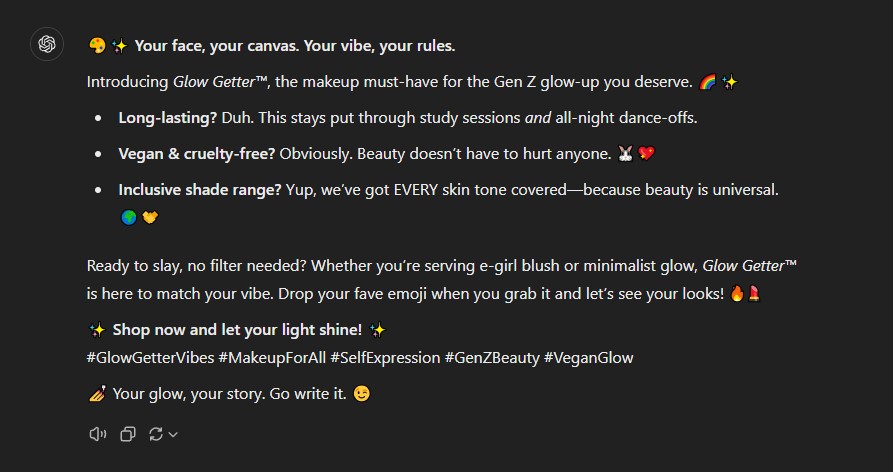The popularity of generative artificial intelligence (Gen AI; GenAI) is through the roof, but that certainly doesn’t mean everyone who’s using it is getting good results. With the experience I have experimenting with Gen AI tools like ChatGPT, I’d wager that most people are using it ineffectively — or at least not to its full potential.
Current tools make the tech seem easy and straightforward to use, which it is for lots of everyday purposes or quick inquiries. But if you’re using it in a professional capacity and want the best, most usable results, there are a few important steps that need to come beforehand.
Using Gen AI the “right” way is much more involved than you’ve maybe been led to believe by all the “AI is coming for our jobs” noise. I don’t endorse relying solely on these tools to write your content. But if you’re looking for that added efficiency that Gen AI can help you achieve while you’re still driving the ship, this is the best way to do it.
Step 1: Choose Your Generative AI Tool
Every Gen AI tool out there today is made differently. Even a couple of the seemingly most similar, like Gemini and ChatGPT, have their unique distinctions. But the first step in choosing your Generative AI application is to determine what you want to use it for, and there are two common options: text or image generation. AI video generation is here, too, but it’s not as refined just yet.
To help you make an informed decision, here are five great generative AI tools — three for text and two for images:
ChatGPT
Arguably the tool that catalyzed the Gen AI transformation, ChatGPT is a solid allrounder for text-based generation. It’s a versatile generative AI model adept at creating human-like text, which can assist you in crafting compelling marketing copy and social media content, to name a couple of applications. That said, it certainly takes a “Jack of all trades” type position meaning that it’s good at lots of things you expect out of Gen AI but doesn’t necessarily specialize in any one area.
contentmarketing.ai
contentmarketing.ai takes ChaptGPT’s “good at a bit of everything” quality and refines it specifically for content marketing so that it excels in numerous facets of the craft. It distills more than 16 years of human content marketing experience into a comprehensive tool that tailors uniquely branded, targeted content for specific platforms.
It also handles briefs — from one-off blog pieces to an entire target audience — and even acts as a proficient project manager, research assistant and more.
Jasper
If you’re looking for integration with other popular marketing tools, Jasper does it well. Like contentmarketing.ai, Jasper specializes in AI-driven marketing content with tools that help you maintain brand voice across various platforms while integrating with Grammarly for writing assistance and Surfer for SEO optimization.
Midjourney
Graphic designers or marketers building decks or needing images for their blogs and want to use AI have lots of great options. Midjourney, though, ranks among the most popular Gen AI applications for image generation. It produces high-quality visuals — some say the highest quality when it comes to Gen AI models for images — enabling marketers to create unique visuals for campaigns or to simply inspire creativity during the design process.
Canva’s Magic Studio
Canva has come a long way since its inception, so much so that it’s pretty much a staple in our industry, with Canva’s Magic Studio pushing it even further in that regard. The platform simplifies content creation with AI features like Magic Switch and Magic Media, which enable users to convert documents to presentations and generate videos from text prompts.
These five examples are all strong choices for their respective use cases, but there are tons more where these came from. Explore these options or research others to find something more suited to you or your role.
Step 2: Experiment With Your Chosen Generative AI Model
Once you’ve browsed suitable Gen AI models and chosen one that aligns with your needs, it’s time to start becoming familiar with how the tool works. Jump in, click around and test out some random prompts to get an idea of how the generative AI tool responds. It will likely never be perfect, i,e., exactly what you’re looking for, so figuring out how to work around its hiccups will be helpful when you actually put it to work.
Step 3: Prompting, Refining, Polishing
This next batch of steps is all about crafting and fine-tuning your prompts for Gen AI. This is often called prompt engineering. As far as I’m concerned, no matter how good the tool is or how much training data it’s eaten up, every single one requires a solid prompting process, strategy and human involvement to achieve results.
1. Craft Your Initial Prompt
Given the other steps in this prompting and re-promting order, your first doesn’t (and likely won’t) give you exactly what you want immediately no matter the Gen AI tool — text or image. Still, your initial prompt should:
- Clearly define the task or desired output.
- Mention the audience, tone and purpose.
- Set limits such as word count, structure or style (if necessary for your piece).
Here’s an example of a clearly defined prompt:
“Write a fun and engaging social media post to promote a new makeup product designed for a Gen Z audience. The tone should be playful, trendy and relatable, incorporating modern slang, pop culture references, or humor where appropriate.
Highlight key benefits of the product (e.g., long-lasting, vegan, inclusive shade range) in a way that resonates with Gen Z values like self-expression, sustainability and inclusivity.
The post should be concise (100–150 words max), formatted for Instagram or TikTok, and include an attention-grabbing hook, hashtags and a call-to-action (e.g., ‘Shop now!’ or ‘Check it out!’). If possible, suggest an emoji or two to enhance the post’s vibe.”
2. Re-Prompting to Refine the Output
Let’s see what we got.

This result is OK. Should you use it word for word? I wouldn’t recommend that. But there are some good elements here. And because the prompt was highly specific and detailed from the start, it should make refining much easier.
At this step, you should:
- Look for missing details, inappropriate tone or deviations from your expectations.
- Gradually improve the output by asking for changes in tone, detail or structure.
- Request variations to explore creative possibilities.
You can prompt small changes like these in smaller, more bite-sized prompts that follow your initial descriptive one. For example, if you don’t like the slang term “glow-up,” you can ask to replace it with something else.
3. Polishing the Content
Once you’ve refined and reformed your results into something you’re mostly happy with, it’s a good idea to call it. Remember: No AI output is ever going to be perfect, so it’d be an arduous effort to strive for that within the generative AI system itself because you probably won’t get it.
Once you’re ready to polish, copy and paste your result into a blank document and get to work! All Gen AI content requires human intervention at multiple points throughout the process to produce something worth publishing.
Things To Do Before Publishing Your AI-Assisted Copy
Responsible AI use means staying actively involved throughout each stage of the content generation process — and especially nearing the end. Before you publish, you need to:
- Verify factual accuracy, especially with data, quotes or statistics suggested by AI algorithms.
- Make your output more engaging. Gen AI tools have a thing for repeating ideas, so make sure to remove fluff that doesn’t add value, add more interesting language and ensure that the finished product reads human, not robot.
You’re On Your Way To Using Gen AI More Effectively
Knowing how to use Gen AI effectively often directly correlates to the value you’re able to extract from any given tool. Yes, you want to be efficient, so an involved prompting process may seem counterintuitive — but the better your instructions are, the more efficient you can be later on.
All generative AI applications are different; each has pros, cons and quirks that require some sleight of hand to work in your favor. AI technology is far from perfect, but these tools are great instruments to have in your pocket so long as they’re under the command of a learned user (you!). The best way to become proficient with your preferred tool, for your ideal AI use cases, is to just jump in and start experimenting. Good luck!






